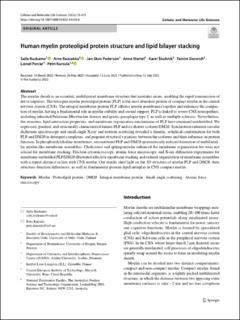| dc.description.abstract | The myelin sheath is an essential, multilayered membrane structure that insulates axons, enabling the rapid transmission of nerve impulses. The tetraspan myelin proteolipid protein (PLP) is the most abundant protein of compact myelin in the central nervous system (CNS). The integral membrane protein PLP adheres myelin membranes together and enhances the compaction of myelin, having a fundamental role in myelin stability and axonal support. PLP is linked to severe CNS neuropathies, including inherited Pelizaeus-Merzbacher disease and spastic paraplegia type 2, as well as multiple sclerosis. Nevertheless, the structure, lipid interaction properties, and membrane organization mechanisms of PLP have remained unidentified. We expressed, purified, and structurally characterized human PLP and its shorter isoform DM20. Synchrotron radiation circular dichroism spectroscopy and small-angle X-ray and neutron scattering revealed a dimeric, α-helical conformation for both PLP and DM20 in detergent complexes, and pinpoint structural variations between the isoforms and their influence on protein function. In phosphatidylcholine membranes, reconstituted PLP and DM20 spontaneously induced formation of multilamellar myelin-like membrane assemblies. Cholesterol and sphingomyelin enhanced the membrane organization but were not crucial for membrane stacking. Electron cryomicroscopy, atomic force microscopy, and X-ray diffraction experiments for membrane-embedded PLP/DM20 illustrated effective membrane stacking and ordered organization of membrane assemblies with a repeat distance in line with CNS myelin. Our results shed light on the 3D structure of myelin PLP and DM20, their structure–function differences, as well as fundamental protein–lipid interplay in CNS compact myelin. | en_US |

